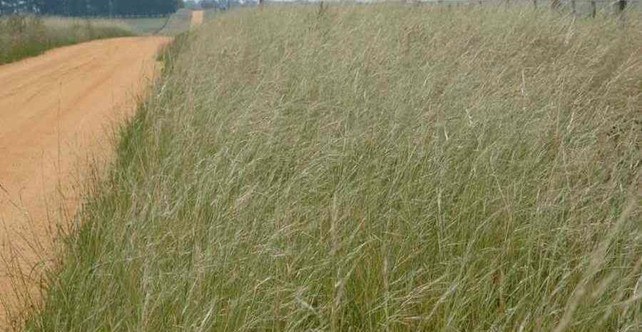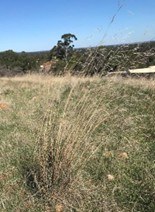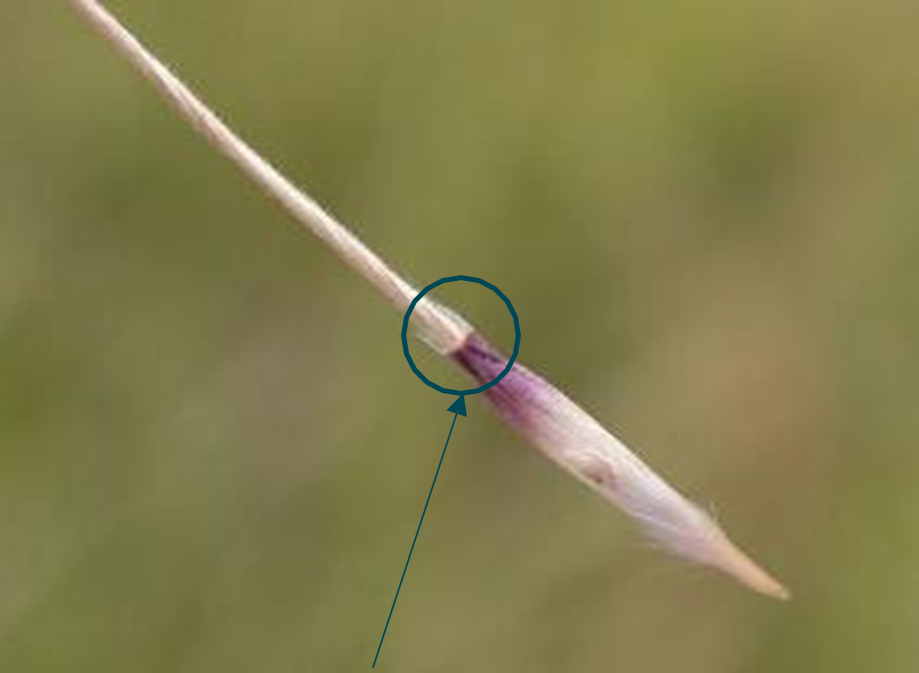Texas needlegrass is a perennial (long lived), winter growing, tussock (clumping) grass which reduces pasture productivity and impacts native vegetation and grasslands. Sharp seeds cause damage to the skin, fleece and eyes of animals.

Description
Texas needlegrass (Nassella leucotricha) is a slow growing, winter active perennial tussock grass with a fibrous root system growing up to 1 m high that can form dense infestations.
Leaves grow to 40 cm long and 5 mm wide, are mid to dark green and flat but may be slightly in-rolled. They are often hairless or may have a silky covering underneath, with sparse short, soft, erect hairs on the upper surface. Distinctive small tufts of hairs are found at the junction of the leaf blade and sheath. Most of the leaves are clumped around the base where stem seeds can develop allowing the plant to reproduce even if the aerial flower stem is removed.
Flowering occurs in spring and early summer but plants will flower at other times if conditions are suitable. The flowering head is a sparse, contracted panicle (cluster), up to 15 to 20 cm long with purplish spikelets. Flower heads carry fertilised seeds which are brown to purple, 1 cm long with a 6 to 9 cm long twisted awn (tail of the seed). Where the awn attaches to the base of the seed, a 1 mm ‘collar’ (corona) of fine hairs are present. This is a distinguishing feature. The long, robust awns generally promote self-burial of seeds in the soil, including hard bare sites.
Similar species
Texas needlegrass is one of 3 declared weedy Nassella species present in the Green Adelaide region. They are all tussock forming grasses, similar in growth habit but with subtle differences in how the seed looks.
Chilean needlegrass (Nassella neesiana) is found around One Tree Hill with Mexican feathergrass (Nassella tenuissima) generally found in garden beds.
All Nassella species can easily be mistaken for a native spear grass (Austrostipa species). Identification of an infestation needs to be confirmed before a control program is begun.

Impacts
Forming dense infestations, Texas needlegrass is considered one of Australia’s worst weeds of native grasslands and pasture. It is unpalatable to stock and has low feed value. This results in selective grazing that reduces desirable pasture species but favours the weed, increasing size of infestations and reducing stock carrying capacity.
Livestock and animals are subjected to the sharp needle- like seed that readily penetrate wool and skin resulting in injury, infection and the downgrading of wool, hides and carcasses. Seeds have been known to blind livestock.
Dense infestations in woodlands and native grasslands exclude desirable species, displacing native plants and grasses and degrading fauna habitat.
Distribution
Texas needlegrass is native to the prairies of North America and Mexico. It prefers an annual rainfall over 500 mm and it can grow in rich to poor degraded soils.
Distribution in the Green Adelaide region is limited but the climatic conditions of the southern part has the potential for significant spread of Texas needlegrass.
A significant infestation exists along the lower reach of the Onkaparinga River. It is also established at Scott Creek CP, Belair NP, Clarendon and Mount Bold Reservoir.
Texas needlegrass seed generally falls within a few metres of the parent plant and the rate of spread around established infestations is slow, resulting in distinct clumpy patches. Seeds are also spread by wind and water or having attached to animals, vehicles, machinery and clothing. Further dispersal is assisted by movement of contaminated fodder, grain or soil.
Management
Texas needlegrass is a declared weed under the Landscape South Australia Act 2019.
We encourage control of plants where there is a risk to human health, agriculture, and biodiversity. Undertaking weed control needs to be done carefully to prevent damage to native vegetation
The sale of Texas needlegrass or contaminated goods; and its movement into new areas or on a public road are prohibited. It is the responsibility of the land owner to destroy these plants on their property. Sightings of this Weed must be reported to Green Adelaide.
We require the destruction of all plants and can assist landholders with the appropriate removal of identified plants.

Control methods
Hygiene
To prevent spread, avoid working in infested areas and undertake any controls prior to seed set. Do not buy or sell contaminated fodder and always decontaminate stock prior to moving. Thoroughly clean clothing, machinery and vehicles when leaving an infested area. Do not move contaminated soil.
Mechanical control
Grubbing or digging out the entire plant can be done any time of year and is effective for small isolated populations; in particular in areas of native vegetation. The whole plant must be disposed of responsibly by deep burial or burning on site or double bagged and placed in the household bin for landfill. Repeated slashing in pastures over flowering season can reduce level of seed development and seed set.
Chemical
Targeted spot spraying of individual plants and small populations during active growth and before seed development. Take care to avoid native plants. For larger infestations where no native grasses are at risk, soil residual herbicides (weedkillers) are effective when applied prior to or during active growth and can significantly reduce follow-up control due to seedling suppression. For advice on chemical options go to PIRSA's Identifying declared weeds.
Observations of weeds can be entered into iNaturalist, an app which can assist with identification.